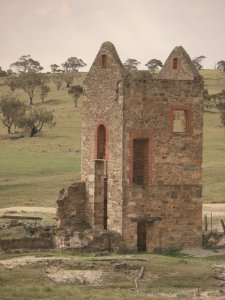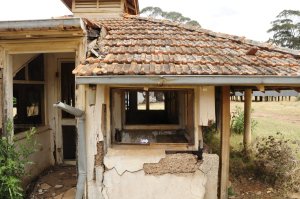By Julia Garnaut
I enjoy nothing more than exploring the history and heritage of an old building. So, when it came time to select a topic for my Masters thesis in Cultural Heritage Management I chose to focus on the built heritage of South Australia, particularly within rural areas. The aim of my research was to investigate how heritage legislation and frameworks assist in the management and conservation of South Australia’s listed rural heritage buildings. To investigate this I undertook archival research, interviews and fieldwork to study the condition of nine different built heritage sites.
Throughout 2011 I criss-crossed the South Australian landscape, visiting the locations of Blanchetown, Burra, Kapunda, Keyneton, Lyndoch, Mintaro, Moculta and Morgan in order to record the present physical condition of state and locally listed engine houses (on mining sites), hotels, pubs, homestead complexes and farm cottages.

State Heritage Listed North Rhine Engine House
One of the biggest challenges of this research was devising a standard methodology for recording the condition of these places. South Australia does not employ ongoing condition reporting as a method of conservation and so I studied what other national and international organisations, such as English Heritage and Monumentenwacht, have utilised. Using these approaches as a guide, I developed a tiered system of assessment, with four levels of condition ranging from good to poor. These condition ratings considered a range of issues, such as the need for maintenance, whether the building was watertight and the condition of the building’s main structural elements.
Results varied, and though only a very small proportion of South Australia’s more than 3000 rural built heritage sites could be considered in my thesis, the results demonstrated that government conservation practices were not always successful. Where ineffective conservation outcomes had occurred, they were the result of the isolation, invisibility and a lack of perceived value of these structures. For rural heritage, many sites are often in varying states of disrepair, and without care are deteriorating rapidly due to abandonment. Isolation and invisibility from the public domain has meant that their deterioration goes unnoticed and, as legislation does not place pressure or offer meaningful assistance to owners to encourage conservation, this cycle continues, often with no one watching.

State Heritage Listed Anlaby Slaughterhouse.
The government’s lack of understanding, support and acknowledgement of the heritage sector in South Australia ultimately leads to what is, for many heritage buildings, a sad story. Because of this I can be quite pessimistic about the future of heritage in South Australia. On the other hand, it is impossible not to be inspired by the passion of the owners of these properties who have worked tirelessly in order to preserve those places that the government has declared important either through a local or state heritage listing. These are the people who keep rural tangible heritage alive in South Australia. They value what is hidden from public view and protect those sites and places that are often viewed as mundane. Without them, little of rural South Australia’s historical built landscape would survive.

